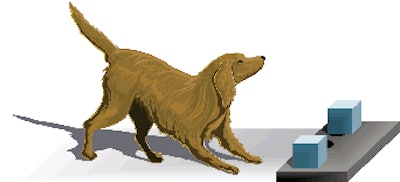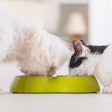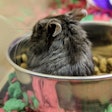
In the companion animal field, palatability assessment is critical for developing foods, treats and medications that pets will willingly consume. Because animals can't declare their preferences, we must use other means to find out what foods they like. Ultimately, any method must enable us to objectively rank an animal's preference between two (or more) foods. CanCog Technologies has developed an alternative approach, the cognitive palatability assessment protocol (CPAP).
Advantages over standard two-pan tests
The standard two-pan method of assessing food preference in pets compares how much of two foods are eaten in a specific amount of time. The test offers several advantages: It generally agrees with owners' reported opinion of their pets' enjoyment of a food, it is low in cost and can be done quickly in terms of data acquisition.
The two-pan test also has inherent limitations. First, the data show significant variability, particularly within individuals. Second, the test has difficulty detecting subtle differences in formulation. Third, the two-pan test doesn't afford control for how different foods may affect the palatability of each other, or demonstrate the long-term effects of caloric intake and nutritional value.
Instead of relying on quantity consumed, CPAP helps the animal indicate which food it prefers without actually eating the food. CanCog uses a unique cognitive procedure based on associative learning that is similar to how consumers select food at a supermarket, i.e., based on packaging.
Cognitive testing procedure in dogs
We have examined cognition in dogs for several years with an emphasis on age-related cognitive changes (Adams, et al., 2000). An example of the testing apparatus we use is shown in Figure 1. In a typical test, the dog enters the apparatus and a technician slides a tray into the response area. The tray contains food wells with objects covering the wells. As with most of our tests, there is only one correct choice. If the dog selects the correct object, it finds a food reward in the well underneath it.
One of our tasks, an object-discrimination learning task, can be solved by using an associative learning strategy. One of two objects is always placed above the food reward. The dog simply has to learn the association between a particular object and the presence of a reward. Once that happens, we reverse the reward-object association. We have found during this reversal test, aged dogs have impaired responses compared to young dogs (Tapp, et al., 2003).
We use a similar procedure to examine palatability, but in these tests there are two objects that could be correct. Each of the two objects is associated with a different food. To ensure the animals have actually used associative learning, we include a third object that has no reward associated with it.
Initial CPAP development
In the initial development of the task, we used a four-phase procedure to compare palatability of a moist food with dry kibble (Araujo and Milgram, 2004). The first phase determined a preferred object out of three. In the subsequent phase, we presented a single, nonpreferred object in association with one of the test foods.
The third phase was used to assess palatability. The dog was presented with three objects, one of which (its originally preferred object) was not associated with any food. Initially, dogs picked their preferred object, but they rapidly learned to avoid it, and with repeated testing every one of the dogs selected the object associated with the wet food (see Figure 2). In the fourth phase, we switched the food-object associations, so the preferred food was now under a new object. The animals accordingly switched their choices to the new object associated with the wet food.
Comparison with the two-pan test
To further validate the CPAP, we compared two foods that were identical in composition, except for the protein source (one was chicken and one was lamb; Araujo, et al., 2004). Based on previous work, we expected the two to be similar in palatability, but that was not the case.
We used six Beagles and found that they all showed a strong preference for the chicken-based food. We then used the same six dogs and an additional seven dogs that were naïve to the diet. We found a similar, but smaller, preference using the two-pan test over the CPAP, but this was mainly driven by the dogs with experience. The dogs that were naïve to the two foods showed no difference in preference.
To compare stability of the two tests, we looked at preference over several days and also following feeding of various diets. Dogs showed the same preference on the CPAP for the entire test period. By contrast, preference according to the two-pan test was highly variableeven in dogs that had previous experience with the food. Similarly, feeding prior to two-pan testing resulted in reduced food consumption during testing, and reduced the ability to detect a difference. No difference in the ability to detect a preference was noted in the CPAP under identical conditions.
Conflict with a satiety-suppressing food
In a final test of the CPAP protocol, we examined the palatability of a specially formulated, appetite-suppressing food. The food was effective, in so far as animals would eat very little, but it also convincingly failed the two-pan test. Was this because the food suppressed appetite, or because of decreased palatability? When we used the standard two-pan test to compare the food with another, the appetite-suppressant diet lost, but again there was considerable variability.
The CPAP procedure, however, told another story; several of the animals showed a consistent preference for the appetite-suppressing food over the standard. There was substantial group variability, but much less individual variability, which is what we would expect if the foods were similar in palatability.
Future directions for CPAP
Like people, dogs can show their preference based on packaging, as demonstrated by the CPAP protocol in which they select an object rather than a food. Food preferences established by CPAP are robust, stable and not influenced by confounding effects of other foods, including those intended to reduce food consumption. The disadvantage of CPAP is that it requires more time than the standard two-pan test and, thus, is more costly.
Because the CPAP requires only small quantities of food and is a robust test, it may be the best for preference assessment of slight changes in food formulations, pharmaceutical formulations and treats. With the industry pushing toward improved health, while still providing highly palatable foods, CPAP may be considered a compelling adjunct to standard palatability tests.


















